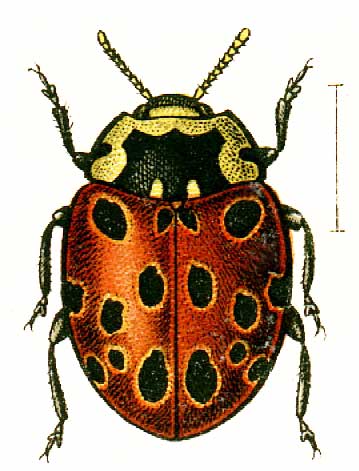
Anatis ocellata
Superregnum: Eukaryota
Cladus: Unikonta
Cladus: Opisthokonta
Cladus: Holozoa
Regnum: Animalia
Subregnum: Eumetazoa
Cladus: Bilateria
Cladus: Nephrozoa
Cladus: Protostomia
Cladus: Ecdysozoa
Cladus: Panarthropoda
Phylum: Arthropoda
Subphylum: Hexapoda
Classis: Insecta
Cladus: Dicondylia
Subclassis: Pterygota
Cladus: Metapterygota
Infraclassis: Neoptera
Cladus: Eumetabola
Cladus: Endopterygota
Superordo: Coleopterida
Ordo: Coleoptera
Subordo: Polyphaga
Infraordo: Cucujiformia
Superfamilia: Coccinelloidea
Familia: Coccinellidae
Subfamilia: Coccinellinae
Tribus: Coccinellini
Genus: Anatis
Species: Anatis ocellata
Name
Anatis ocellata (Linnaeus, 1758)
Original combination: Coccinella ocellata Linnaeus, 1758
Synonyms
Coccinella hebraea Linnaeus, 1758
References
Linnaeus, C. 1758. Systema Naturae per regna tria naturæ, secundum classes, ordines, genera, species, cum characteribus, differentiis, synonymis, locis, Tomus I. Editio decima, reformata. Holmiæ: impensis direct. Laurentii Salvii. i–ii, 1–824 pp DOI: 10.5962/bhl.title.542: 366. Reference page.
Links
Anatis ocellata Taxon details on Fauna Europaea
ZooBank: B6FB66ED-A1DF-463C-A1B0-4E3646BFC15E
Natural History Museum: Anatis ocellata
Vernacular names
Deutsch: Augenmarienkäfer
English: Eyed Labybug
suomi: Isopirkko
français: Coccinelle à ocelles
Nederlands: Oogvleklieveheersbeestje
norsk nynorsk: Augeflekka marihøne
norsk: Øyeflekket marihøne
polski: Biedronka oczatka
русский: Коровка глазчатая
svenska: Ögontecknad nyckelpiga
Anatis ocellata, commonly known as the eyed ladybug, is a species of ladybug in the family Coccinellidae. It has black spots on a red background, with each spot surrounded by a yellowish halo. In one color variation, a specimen found in Scotland was reported having the spots fused to form longitudinal lines.[1]
Distribution
The species is found from continental Europe, in transcontinental Russia, in central Asia, in Mongolia, in northern China, in Western Canada and to the Korean peninsula.[2]
Biology
The primary habitat is temperate coniferous forest including Central European mixed forests and Sarmatic mixed forests, Scandinavian montane birch forest. Most frequently on pines but also on Picea abies and other Picea species, Betula pendula and other Betula species, and Populus tremula. Adults are entomophagous, mainly feeding on aphids on coniferous trees [3]
The species feeds on aphids such as Eucallipterus tiliae, Tuberculatus annulatus, Euceraphis betulae, Cavariella konoi, Acyrthosiphon ignotum, A. pisum, and Macrosiphoniella artemisiae.[4] They prefer pine aphids (family Adelgidae), and are attracted to the scent of pine.[5] The defensive alkaloid compound 2-dehydrococcinelline has been isolated and identified from this species.[6] The adults and larvae also feed on leaf hopper larvae on P. tremula.[7] The adults overwinter.
References
Liston AD. (1979). "An unusual aberration of Anatis ocellata (Linnaeus) (Coleoptera: Coccinellidae)". Entomologist's Gazette. 30 (1): 21–22. ISSN 0013-8894.
N. B. Nikitsky and А. S. Ukrainsky, 2016 The Ladybird Beetles (Coleoptera, Coccinellidae) of Moscow Province ISSN 0013-8738, Entomological Review, 2016, Vol. 96, No. 6, pp. 710–735 ISSN 0013-8738 online pdf
Dyadechko, N.P., The Coccinellidae of the Ukrainian Soviet Socialist Republic (Academy of Sciences of the Ukrainian SSR, Kiev, 1954) [in Russian].
Kalushkov P, Hodek I (2001). "New essential aphid prey for Anatis ocellata and Calvia quatuordecimguttata (Coleoptera: Coccinellidae)". Biocontrol Science and Technology. 11 (1): 35–39. doi:10.1080/09583150020029727.
Acorn J. (2007). Ladybugs of Alberta: Finding the Spots and Connecting the Dots. University of Alberta. p. 24. ISBN 9780888643810.
Lebrun B, Braekman JC, Daloze D, Pasteels JM (1997). "2-Dehydrococcinelline, a new defensive alkaloid from the ladybird beetle Anatis ocellata (Coccinellidae)". Journal of Natural Products. 60 (1): 1148–9. doi:10.1021/np9702695.
Savoiskaya, G.I., Coccinellid Larvae (Coleoptera, Coccinellidae) of the Fauna of the USSR (Nauka, Leningrad Branch, Leningrad, 1983) (Keys to the Fauna of the USSR, Published by the Zoological Institute of the Academy of Sciences of the USSR, No. 137) [in Russian].The adults overwinter in litter and among fallen leaves.
Retrieved from "http://en.wikipedia.org/"
All text is available under the terms of the GNU Free Documentation License

